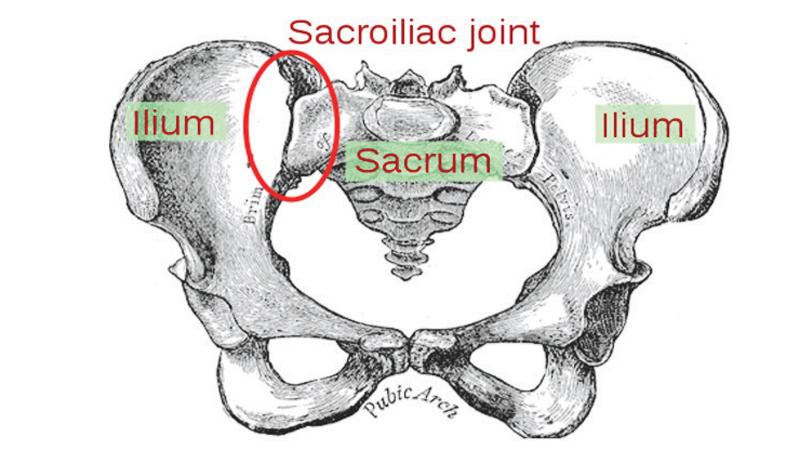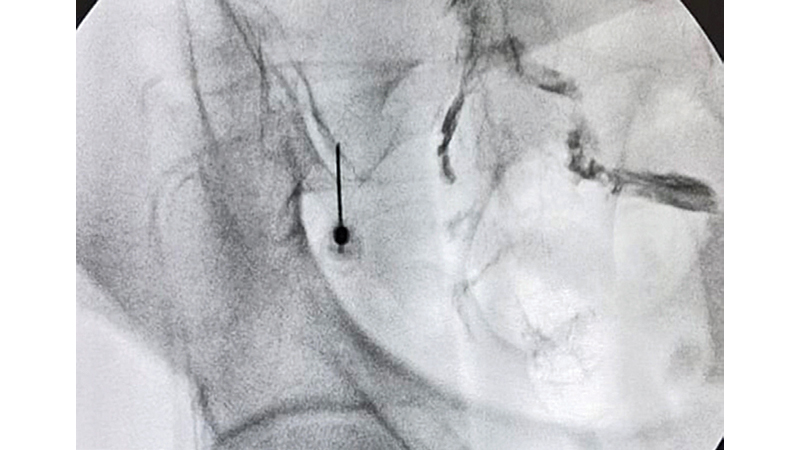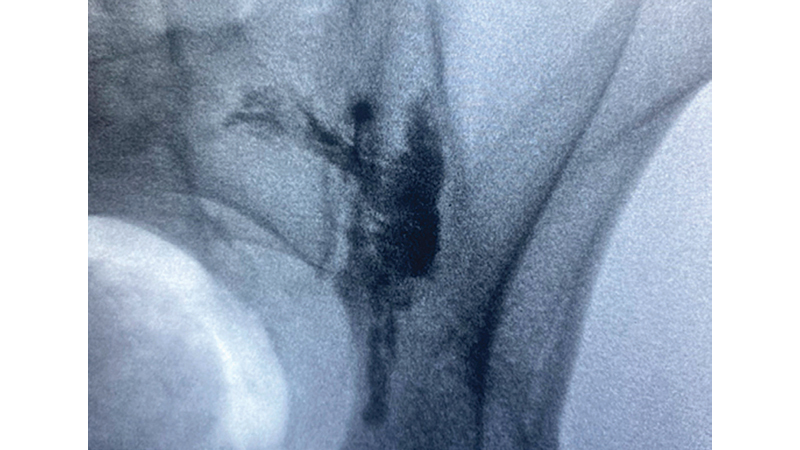
 A main cause for lower back pain is sacroiliac joint (SIJ) pain.
A main cause for lower back pain is sacroiliac joint (SIJ) pain.
The sacroiliac joint contributes to 20-30 percent of lower back pain and is under diagnosed. There are two sacroiliac joints on either side of the lower back. The lower back is connected to the pelvis by the SIJ via the sacrum and it is situated in the area of the buttock. Sacroiliac joint pain radiates to the lower spine, groin and the thigh. It is an aching pain which can also reach down the leg. Differentiating SIJ pain from other causes of back pain is challenging. It is mainly a clinical diagnosis. SIJ is the size of the palm of the hand. It’s a large joint with less movement. It is covered by a synovial sheath and ligaments. Around 35 muscles are attached to the sacrum which forms part of the SIJ. These muscles will stabilise the SIJ.
SIJ provides stability to the spine and the lower extremities.

X ray view of the SIJ. Needle is on the left sacroiliac joint
Causes of SIJ pain
1. Trauma (injury) – Due to accidental damage to the joint. It can give rise to pain in the joint.
2. Hypermobility - This will be discussed in a separate column in more detail, i.e. Ehlers Danlos syndrome. Patients with the hypermobility syndrome will move their joints three to four times more than a normal person. As a result joint pain is more common in this group of patients. SIJ pain is common in this group.
3. Degeneration - Due to wear and tear.
4. Osteoarthritis - It is not uncommon for the SIJ to be affected due to osteoarthritis. Osteoarthritis occurs in weight bearing joints and SIJ is a weight bearing joint.
5. Inflammation - Ankylosing spondylitis, sero negative arthritis, inflammatory bowel disease can cause inflammation of the SIJ (Sacroilitis).
Diagnosis
1. Mainly by clinical examination
2. X ray of the Pelvis
3. Blood investigations such as ESR, C reactive protein
Treatment
1. Analgesics according to World Health Organization ladder.
2. Exercises - mild to moderate exercises
3. Physiotherapy
4. Sacroiliac joint injection under X ray guidance. Once the patient responds to an SIJ injection positively (reducing pain) it will confirm the diagnosis and act as the treatment as well. If the pain comes back a repeat injection or radio frequency denervation to the SIJ can be carried out.
5. Radio frequency denervation (RFD) - For long term pain relief RFD can be carried out freezing the nerve endings to the joint.

Typical X ray view with a dye in the SIJ (sacroiliogram)
Dr Namal Senasinghe MBBS, Dip in Pain Med, FFARCS, FFPMCA, CCST (U.K.) is a Consultant in pain medicine with international experience. He lived and worked in the U.K. for 25 years of which 18 years were as a Consultant in pain medicine. His entire postgraduate training was in the U.K. After his return to Sri Lanka he opened the London Pain Management Centre at 31, Horton Place, Colombo 7, on September 2, 2020.
All X-rays are taken in Sri Lanka.
Website www.londonpainmanagementcentre.co
Email [email protected].U.K.
